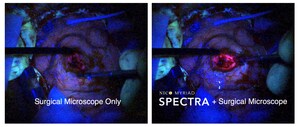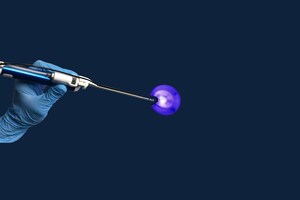The standard of care for treating an ICH has always been medical management through monitoring the patient in ICU and waiting to see if there was improvement over time. This type treatment leaves the blood in the head, resulting in 32-50 percent of patients dying and leaving 80 percent of survivors significantly disabled in speech, motor skills and cognitive functions.
Before today, neurosurgeons would have said operating on an intracerebral hemorrhage to remove the blood was an "almost never" scenario, believing that it might hurt the patient more than help. But now, there are no longer absolutes. Brain surgeons and patients have increasing hope that they can successfully operate on these devastating strokes because of new technology and a new, safe way of reaching the hemorrhage.
The technology, called BrainPath, safely provides access to the clot by moving through the natural folds of brain tissue and parallel to the brain's critical fiber tracts that control thinking and body movements. Using the uniquely designed tube, surgeons can now access brain bleeds without cutting through healthy tissue and operate through a dime-sized hole. Most importantly, they can do this ultra-early – within 8-12 hours of the stroke – and potentially stop brain injury, ultimately improving the functional recovery of the patient. And there's proof.
Clinical studies have shown improved patient recovery when using this BrainPath tube for accessing the bleed or clot, with more than 95 percent clot reduction, no re-bleeds, no procedure-related deaths, no new issues with thinking or the ability to do activities after surgery, and the ability to walk in 63 percent of patients. Patients also showed significant improvement in the symptoms they came to hospital with after surgery, as well as the ability to perform typical day-to-day activities, known as functional recovery.
Further evidence to build on these important clinical study results is being gathered through a multi-center randomized controlled trial that will evaluate how effective early surgical intervention is after using BrainPath following intracerebral hemorrhage versus the wait-and-see medical management approach. The goal of the trial is to show improved functional recovery for patients. NorthShore University Health, as well as stroke centers associated with Emory University School of Medicine and at least a dozen other institutions, will be participating in the trial that is expected to last about three years.
This is a new way of thinking about brain surgery, likely the last medical specialty area to move to minimally invasive techniques because of the complexity involved in the surgery. What we have learned, and what the trial will help prove, is that the way you access a brain bleed matters to how patients recover their ability to perform daily activities and live independently. It matters to the surgeon, to hospital economics because of reduced days in ICU and overall length of stay in the hospital, and to the patient who now has a surgical option to this very deadly form of stroke and the opportunity for improved recovery.
Learn more about BrainPath by visiting www.NICOneuro.com.
Co-Authors
Julian Bailes, MD
Chairman, Department of Neurosurgery
NorthShore University HealthSystem, Chicago
Surgical Director, NorthShore Neurological Institute
President, Subcortical Surgery Group
Jim Pearson, President & CEO
NICO Corporation, Indianapolis
Contact: Sue Goin
[email protected]
317.402.8690
Photo - http://photos.prnewswire.com/prnh/20161028/433857
Photo - http://photos.prnewswire.com/prnh/20161028/433856
SOURCE NICO Corporation
Related Links
http://www.NICOneuro.com




Share this article